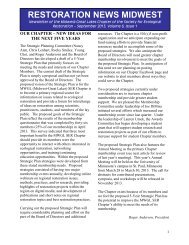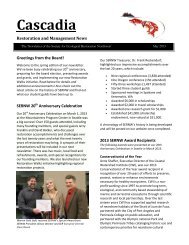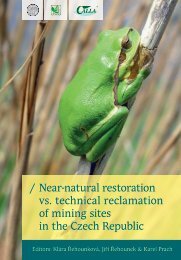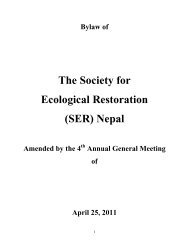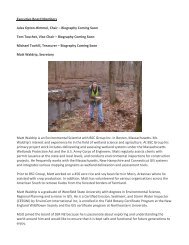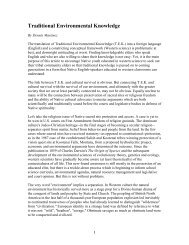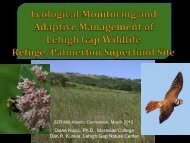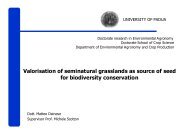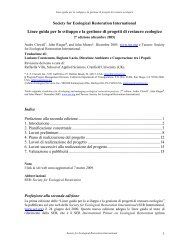THE WORLD CONFERENCE ON ECOLOGICAL RESTORATION
A Global Challenge - Society for Ecological Restoration
A Global Challenge - Society for Ecological Restoration
Create successful ePaper yourself
Turn your PDF publications into a flip-book with our unique Google optimized e-Paper software.
14 Plenary Sessions<br />
Ecosystem Degradation and Restoration in the Western<br />
China<br />
Bojie FU, Guohua LIU, Yihe LU<br />
Key Lab. Of Systems Ecology, Research Centre for Eco-Environmental Sciences, Chinese<br />
Academy of Sciences, P. O. Box2871, Beijing, 100085, China<br />
Western China covers 12 provinces with an area of about 6600 thousand<br />
squire kilometers accounting for about 68.8.3% territory of the whole country.<br />
The geomorphology patterns are unique constituting high mountains and deep<br />
river valleys, plateaus, and large basins. It can be divided into zones from middle<br />
temperate zone to peripheral tropical zone according to the latitudinal temperature<br />
gradient with additional two vertical zones of plateau temperate and<br />
sub-frigid zones. According to the humidity conditions, it varies from extreme<br />
arid to humid regions. Therefore, the natural ecosystem types are diverse<br />
along horizontal and vertical gradients. The latitudinal pattern of ecosystems<br />
from the south to north is tropical rain forest, sub-tropical evergreen broadleaf<br />
forest, temperate grassland, and temperate desert. Along the longitudinal<br />
direction from the east to west, there is temperate forest, temperate grassland,<br />
desert grassland, and desert. Arid valley shrub land, evergreen broad-leaf forest,<br />
deciduous broad-leaf forest, sub-alpine coniferous forest, sub-alpine<br />
shrub, sub-alpine grassland, sub-alpine meadow, and alpine sparse vegetated<br />
ecosystem distribute vertically along the elevation gradient of high mountains.<br />
There are 7 out of the 11 terrestrial biodiversity hotspots in western China.<br />
However, owing to the impacts of global environmental change, local environmental<br />
fragility, and high population and development pressures, many environmental<br />
problems have emerged as soil and water loss, desertification, ecological<br />
degradation of grasslands and forests, the shrinking of wetlands, soil<br />
saltification and alkalinization, and the loss of biodiversity. The natural driving<br />
factors of these problems are the extreme climatic conditions and the unique<br />
geomorphological conditions. The human factors include the rapid increase of<br />
population, the irrational reclamation of natural ecosystems, the uncontrolled<br />
use of water resources, over grazing, over cutting, poor land management, the<br />
unconsciousness of the environment, and the ignorance of the environmental<br />
laws. It is an urgent need to restore the degraded ecosystems under the national<br />
western development strategies. Multidisciplinary cooperation and<br />
multi-stakeholder participation are indispensable for this restoration campaign.<br />
The principles of the restoration include: 1) eco-regional and even site<br />
specific and problem oriented restoration; 2) natural succession based restoration;<br />
3) multi-objective and multi-measure restoration; 4) scientific and comprehensive<br />
planning based restoration; and 5) participation driven restoration.<br />
The success of the ecological restoration initiative in the western China depends<br />
on the establishment of a rational ecosystem management framework,<br />
which necessitate the enhancement of scientific research on the issues pertinent<br />
to ecological restoration.



